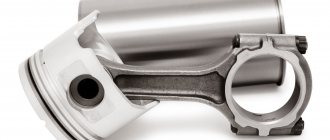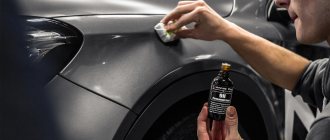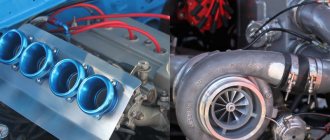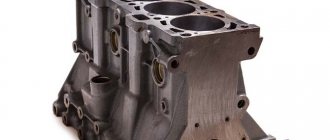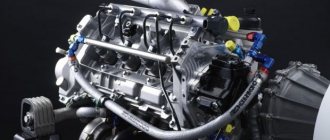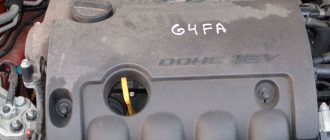TSI engines (Turbo Stratified Injection, from the English turbocharging and stratified injection) are gasoline power units with direct (direct) fuel injection and turbocharging. These motors are produced by the German concern WAG and are installed on various models of Audi, Volkswagen, Seat, Skoda, etc. cars.
We also recommend reading the article about what a TDI engine is. From this article you will learn about the features, operating principle, advantages and disadvantages of this type of diesel engine.
TSI engines (full name TFSI, usually the name is used for Audi models) are built on the basis of naturally aspirated FSI engines with direct injection (Fuel Stratified Injection, which means layered fuel injection).
What is a TSI engine
The requirement of environmental standards in Europe contributed to the development of the TSI engine, which, with a small displacement, provides high performance and low fuel consumption. The work is based on the use of dual supercharging and direct fuel injection. A mechanical compressor works in tandem with a turbine. Such engines are installed on brands Skoda, Audi, Volkswagen, Seat and some others.
TSI engine
Development of the TSI engine began in the early 2000s, but the engine went into mass production in 2005. This was the first TSI line to be significantly updated in 2013, but more on that below.
Many people argue over the correct decoding of the TSI abbreviation. It is worth saying that the original name was Twincharged Stratified Injection. Afterwards, models with one turbine began to appear and the abbreviation began to be translated as Turbo Stratified Injection. In Audi cars, this power unit is labeled TFSI.
The principle of operation of a turbocharged engine
The presence of turbocharging did not introduce significant changes into the combustion organization process. The engines use several methods to improve efficiency through the inherent advantages of direct injection:
The latter is ensured by a special injection mode at the bottom of the piston with swirling flow and supply of a normal mixture to the spark plug electrode zone, when in the rest of the cylinder the mixture is extremely lean and unsuitable for ignition.
Turbocharging provides accelerated filling of the cylinders with air, but does not work well at low speeds due to insufficient spin-up of the turbine.
Therefore, many engines in the line use a double supercharging system, when first a mechanical rotary compressor driven through a belt from the crankshaft pulley is connected to an electromagnetic clutch and an additional bypass valve.
Switching between different modes of this combination of two compressors is controlled by the electronic engine control unit. It also controls the use of different direct injection modes, depending on the nature of the load and the required torque.
As a result, it is possible to obtain unique indicators from the engine:
The TSI family turned out to be extremely knowledge-intensive not only during the development process, but also during mass production, which is associated with the manifestation of shortcomings and the need to eliminate them using constructive methods. High performance does not come for nothing.
Line of motors
The TSI line is represented by a wide range of engines. The first generation (2005 – 2013) was represented by EA111 and EA888 Gen.2 engines. These are engines of 1.0, 1.2, 1.4, 1.6, 2.0 and V3.0.
In Russia, the most popular are 1.2 and 1.4 TSI. Engine 1.2 capacity 90/105 hp. has only one turbine without a compressor. Volume 1.4 has variations with one turbine or compressor + turbine. Engine power from 122 hp. up to 170 hp in stock configuration. The top of the TSI line is the 3.0 V6 333 horsepower engine, which, for example, is now installed on the Volkswagen Touareg.
The first TSI line had significant shortcomings, which we will talk about a little later. For the most part, these shortcomings were corrected in the next generation of motors EA211 and EA888 Gen.3.
As you can see, these motors have a lot of modifications.
According to the developers, the engine life is designed for 300,000 km.
Typical problems and malfunctions
The 1.2 TSI and 1.4 TSI engines have earned a bad reputation due to the EA111 family. Against this background, the EA211 series is the standard of reliability.
However, among the EA 111 there are units that are the least risky. These are mainly varieties with a turbine (122 and 125 hp).
Stay away from the Twincharger version (turbine + compressor), which caused numerous problems throughout its production (2005-2015).
During the production process, VAG modified the EA111 engines. So, in 2010, a modified phase regulator appeared (for example, for SAHA with marking 03C109088E), the timing chain and its tensioner were updated.
Due to a defective tensioner, the stretched chain could jump or break, which inevitably led to valves meeting the pistons. Replacement using original parts will cost 15-25 thousand rubles - depending on the workshop and the amount of work (with or without a phase variator).
The list of parts to be replaced includes: chain, guides, tensioner, and usually gears and a phase shifter. The first symptom is a rattling noise after starting.
In addition to the above malfunctions, oil consumption increased and turbine malfunctions were observed.
The EA111 Twincharger versions had a compressor that was switched off by an electromagnetic clutch at high speeds (around 3000). It is combined with a water pump. Sometimes the clutch began to make noise. The cost of repairs is 8-12 thousand rubles. After 2010, the disease began to occur less frequently.
Damage to pistons and rings usually affected the EA111 Twincharger. But from time to time I got a simple 1.4 TSI and 1.2 TSI. The cost of repairs is over 50,000 rubles.
Features of the device and operation of TSI
Let's look at the operation of the most popular 1.4-liter TSI engine. It develops power of 125 kW, torque of 249 Nm in the range of 1750-5000 rpm. Fuel consumption is only 7.2 liters.
Basic elements of the TSI engine
In fact, TSI engines are a continuation of the FSI line, which also uses direct fuel injection technology. The fuel is supplied directly into the combustion chamber through injectors at a pressure of 150 bar. A high pressure fuel pump is provided for this purpose.
Depending on the conditions, different preparations of the air-fuel mixture are provided. At low and medium speeds, layer-by-layer mixture formation occurs. Air enters the combustion chamber at high speed. Fuel injection occurs at the very end of the compression stroke, thereby providing a high compression ratio of 10:1 despite dual boost. The excess air that occurs after combustion acts as a heat insulator.
With homogeneous (stoichiometric) mixture formation, fuel injection occurs on the intake stroke, thereby ensuring a homogeneous mixture that burns as efficiently as possible.
TSI twin turbocharging system
With the throttle valve wide open, a lean, homogeneous mixture is formed. The air in the cylinders moves very intensively. Exhaust gases are also added to the composition at a level of 25%. Fuel is supplied during the intake stroke.
Double supercharging gives excellent traction. The mechanical compressor provides full torque already at low speeds down to 2000-2500 rpm. This eliminates the occurrence of so-called turbo lag. With sufficient exhaust gas pressure at 2500 rpm, the damper opens and the turbine is switched on, thereby creating an air pressure of 2.5 bar. The mechanical compressor is belt driven.
Device
I won’t delve too deeply into the structure, but I will try to touch on important elements and differences. First, look at the main blocks, here is a small diagram.
The unit has been significantly redesigned, especially worth noting - two superchargers, a new cooling system, fuel injection, and a lightweight engine block. Now, in order.
1) Mechanical compressor and turbocharger, main differences
The device is such that they are located on opposite sides of the block. An ordinary compressor uses the energy of exhaust gases (located on one side). The exhaust gases themselves spin the turbine wheel, then through special drives, compressed air is created into the engine cylinders (I wrote about a simple turbocharged version). The operating principle of the old type of engine is more efficient than a simple gasoline engine, but not as efficient as a TSI. A simple turbocharged unit is not very effective at idle and low speeds; the so-called “” effect appears (when full power appears only from 3000 rpm and above), that is, you always need to gas.
The same cannot be said about TSI. The only difference is that it also contains a mechanical compressor (on the other hand), which operates at low speeds. In this way, compressed air is always injected (through special devices). Thanks to this mechanical compressor, the power does not drop, even from the bottom there is excellent traction, the “turbo pit” effect is defeated!
Excellent symbiosis of work: a mechanical supercharger at the “bottom” and a regular classic TURBO “at the top”, no power failures!
There are also improvements here. The concept of “liquid cooling” appears (conventional turbo variants are cooled only by air). The cooling system has pipes that pass through. Due to which the main air is pumped into the cylinders, the pressure indicator is higher. The result is uniform filling of the combustion chamber with the fuel mixture and increased dynamics. Already at 1000 - 1500 rpm we get the declared 210 Nm. Here is a small diagram of the cooling system, you can see the location of the pipes.
3) Fuel injection
A very interesting system. Firstly, the fuel is supplied directly to the engine cylinders (bypassing the fuel rail), and secondly, mixing with air occurs “layer by layer”, thereby achieving combustion with high efficiency. These two factors allow you to slightly increase power and reduce fuel consumption. Here is a diagram of the main elements of the fuel system.
4) Lightweight block
It should be noted that engineers struggled to reduce the weight of the unit unit. And you know, we managed to remove about 14 kilograms - a significant figure. We used a new design for the placement of the block itself and the head, new camshafts and a plastic cover.
TSI have proven themselves to be very productive engines - with a relatively small volume you can achieve very high horsepower figures. So the usual turbocharged type from Volkswagen, with a volume of 1.2 liters, has a power of approximately 90 hp, TSI can produce about 102 hp with the same volume.
Advantages and disadvantages
Thanks to its design, the TSI engine has many advantages. Among them:
- high engine performance with a small volume;
- good traction even at low revs;
- efficiency (consumption 7.2 l);
- compactness and light weight (weight reduced by 14 kg);
- tuning and boosting capabilities;
- environmental friendliness (less carbon dioxide emissions).
But with all the advantages, there are also disadvantages. This is especially true for the EA 111 and EA888 Gen 2 engines:
- high oil consumption (oil change after 7.5-10 thousand kilometers);
- timing chain stretching and breakage;
- high demands on oil quality and fuel quality;
- slow engine warm-up.
Design Features
Fundamentally, individual engine components and systems do not differ from analogues, but some design solutions are quite original.
Turbocharging system
The main feature was the use of double supercharging on some engines, but not with large and small turbines, as is sometimes done, but with the addition of a mechanical supercharger.
There are several operating modes of the system:
This flexibility allows you to maintain maximum efficiency and minimum aerodynamic losses in the tract throughout the entire speed and torque range, aligning its shelf with the external speed characteristics of the engine.
Recently, quite efficient turbines with variable geometry and low inertia have appeared, which has made it possible to abandon a rather expensive and massive mechanical compressor.
Cooling system
High boost pressure requires cooling of the air entering the cylinders. When it heats up, the engine's resistance to detonation decreases and efficiency deteriorates due to the lower density of the hot gas at the inlet. Therefore, engines use an intercooler - an additional radiator with a liquid heat exchanger.
This solution is almost universally used in diesel engines; it is no less appropriate in highly efficient gasoline internal combustion engines.
Injection system
Gasoline is sprayed directly into the cylinders through multi-point nozzles, which ensures good homogenization of the mixture. The higher the injection pressure, the more efficient this process is, so injectors and a fuel pump of very high pressure, up to 150 atmospheres, are used.
The direction of the torch of all holes in the injectors is oriented towards the bottom of the piston, which allows layer-by-layer mixture formation due to the reflection of the flow and its direction to the spark plug. Changing the injection timing implements all the other modes listed above.
Cylinder block
There are different versions of the blocks, including stronger cast iron ones, but recently aluminum blocks with pressed cast iron sleeves have been used.
Such solutions are used in many other engines, not always successfully. The fact is that reducing the thickness of the liner walls to improve heat transfer leads to warping and scuffing.
Not all engines of the family managed to completely solve this problem, especially when using short pistons with minimal friction losses, but this is a problem with almost all modern engines.
Basic faults
The timing chain has become the real Achilles heel of these engines. Since the TSI engine is highly loaded, it stretches quickly. The chain tensioner also turned out to be problematic. It is recommended to check the chain after 50-70 thousand kilometers. The consequences of a broken timing chain are well known to everyone: bending of valves, scuffing of cylinders and, as a result, very expensive repairs or, in general, replacement of the power unit. Replacing the chain and other components (pacifier, tensioner) is quite expensive.
There is hot air in the intake manifold, and oil mist also enters it, which leads to coking of the intake manifold, throttle valve, intake valves and oil rings. A breakdown of the oil separator can also lead to coking. The driver needs to carefully monitor the oil level. Fill only with high-quality oil recommended by the manufacturer. High consumption is most likely not a problem, but a consequence of all forced power units. The so-called “oil burn” is formed due to the turbine, high torque and the design of the pistons themselves.
Oil also plays an important role in turbine cooling. Poor quality or used oil will lead to clogging and breakdown of the turbine.
High-quality fuel is no less important. It is recommended to use gasoline with an octane rating of 95 or higher.
Slow warm-up is a consequence of the use of a complex cooling system for TSI engines. Without a dual cooling system, overheating is guaranteed.
In the third generation of TSI EA211 and EA888 Gen.3 motors, the developers managed to solve some problems. This mainly concerns the timing chain and slow warm-up. The chain was replaced with a belt. The belt life remained approximately the same (50-70 thousand km), but it is much easier and cheaper to replace. On third-generation 1.8 and 2.0 tsi engines, a higher-quality timing chain with a service life of 150 thousand km or more was installed.
Modern 1.2 and 1.4 engines use a lightweight body, but cast iron liners. In other models, the cast iron block also remains. This made it possible to lighten the engine by 22 kilograms.
Advantages and Disadvantages of TSI
Such an advanced design cannot but have advantages over simpler motors. This is due to the maximum use of fuel energy in all modes:
- high efficiency, we managed to get a real jump, reaching up to 20% even in comparison with fairly good engines;
- compliance with all environmental standards, which was largely achieved thanks to an effective multi-component neutralizer, which can be maintained in optimal mode due to excellent engine controllability;
- ease of obtaining the required power, which, thanks to an effective injection system and high-quality supercharging, is limited only by the strength of the parts; engines are easy to chip-tuning;
- small dimensions and weight of engines while maintaining recoil capabilities.
The novelty and complexity of the TSI family could not but bring with it significant disadvantages:
- realizing the capabilities of engines requires the use of only high-quality gasoline and oils, they do not tolerate the presence of sulfur in the fuel, and the debate about which oil is better for these engines does not subside, factory recommendations suffer from excessive optimism;
- attempts to reduce losses in engines led to a decrease in service life, especially on engines of the first generations, timing chains quickly stretched out, oil consumption exceeded the norms usual for other engines, and the pistons could not withstand the loads;
- the engines suffer from diseases typical of direct injection associated with deposits on the intake valves; some models even had to be equipped with additional injectors in the intake manifold;
- complexity entails a high price for cars, this is not always justified by a decrease in gasoline consumption;
- Maintenance and repairs are very expensive and require highly qualified personnel.
The latest generation engines partially get rid of some characteristic flaws in the design of their predecessors, but a number of problems have not yet been resolved, for example, everything related to oil consumption.
Nevertheless, the engines are widespread, including on budget models, and their further development in the form of internal combustion engines with the Miller cycle and variable geometry turbines indicates that the concern is continuing along the chosen path of using TSI technologies.
Volkswagen EA211 1.4 CZDA TSI engine: reliability, efficiency, service life, pros and cons
Good afternoon, today we will talk about characteristics, reliability, service intervals, efficiency, maintainability, practicality, breakdowns ( sores)
), resource, advantages and disadvantages of the Czech-German
Volkswagen
gasoline with a
TSI
EA211
”
engine line the CZDA
with a volume of
1
.
4
liters, which are equipped with the most popular models of the
VAG
, for example,
VW Beetle
/
Golf
/
Passat
/
Tiguan
/
Sharan
/
Touran
,
Skoda Yeti
/
Octavia
/
Kodiaq
, as well as
Audi A4
/
A5
.
The petrol power plant, equipped with a
TSI
with a total cylinder capacity of
1395 cubic meters
the CZDA
series , was first demonstrated to the public at the
Frankfurt
in mid
-2014
.
Motor 1
.
4 TSI CZDA
family
EA211
is a joint Czech-German development of the
VAG
.
The power unit in question is considered an innovative type of Volkswagen internal combustion engine, which is why it belongs to the rather controversial and controversial engines of the EA211 line. From 2014
to the present day, motor
1
.
4 TSI CZDA
is successfully produced in
the Czech Republic
(
Mlada Boleslav
) and is installed on the widest range of VAG car
models
.
Since the end of 2019,
the EA211
engine line has gradually been replaced by newer power units of the
EA211-NEO
.
The EA211-TSI
engine line includes
the following engine series
:
CXSA
,
CZCA
,
CJZA
,
CJZB
,
CHPA
,
CMBA
and
CZEA
.
{banner_adsensetext}It is worth saying that the reviewed motor is 1
.
4 TSI CZDA
, by and large, is intended for models in the mid-price segment, which is very popular in Europe and some countries of the post-Soviet space (
Russia, Belarus, Ukraine
).
So, the 1.4 liter engine of the CZDA series is equipped with 16
valves (
4 valves for each cylinder, located in-line
), a
DOHC
(
2 independent camshafts
) with hydraulic compensators and phase regulators (
for reference: phase regulators are installed on the intake and exhaust
).
GRM
)
drive a belt drive
.
In addition, the 1.4-liter internal combustion engine is equipped with a
TSI
and has
150
horsepower and
250
Newton per meter of torque.
The power supply system of the power unit is electronic, injection type, compression ratio is 10
points, which corresponds to the 98th grade of gasoline recommended for refueling.
Additionally, the power unit is equipped with a turbocharger
the IHI RHF3
series .
The table below clearly shows the main technical indicators of the power plant 1
.
4 CZDA
(CLICK ON TABLE TO ENLARGE).
What is the fuel consumption of engine 1
.
4 TSI CZDA?
Fuel consumption by the power unit of the CZDA series, using the example of the 2021 Volkswagen Tiguan with a manual transmission, averages
:
in
city
mode - 8.3 liters per 100 kilometers;
in suburban
mode - 5.4 liters per 100 kilometers and in
mixed
mode - 6.5 liters per 100 kilometers.
{banner_reczagyand}
How the motor works 1
.
4 TSI CZDA?
CZDA
small-volume petrol engine, jointly developed by
Volkswagen
and
Skoda
, is designed from scratch on a modern
1.4-
liter engine platform, and it is unlike many other powerplants in the
EA211
.
Head and cylinder block of the power unit 1
.
4 TSI CZDA
is made of high-melting aluminum, and instead of
a timing chain
, the engine is equipped with a classic
timing belt
.
In addition, the internal combustion engine under consideration is equipped with innovative phase regulators, which are located on both the intake and exhaust shafts.
After the latest modernization, engine power increased from 140 to 150 horsepower
.
Engines 1
.
4 CZDA
received an updated design of the exhaust gas system, and therefore the environmental class of the power plant increased to the Euro-6 level.
On what car models is the engine installed 1
.
4 TSI CZDA?
The motor in question is one of the most widespread and popular of the entire family of
EA211
, along with
1
.
6 MPI CWVA
.
The 1.4-liter
CZDA series power unit Volkswagen
/
Skoda
/
Audi
.
The table below clearly demonstrates all models of the VAG
equipped with an internal combustion engine
1
.
4 CZDA
(CLICK ON TABLE TO ENLARGE).
What are the advantages and disadvantages of the engine 1
.
4 CZDA?
Based on
reviews
from many car owners and car specialists about the
1
.
4 CZDA
, we can conclude that in general the power unit turned out to be quite
reliable
,
practical
,
economical
and moderately
durable
.
Below in the table we have listed the main pros
and
cons
of the 1.4 CZDA engine from
VAG
(CLICK ON THE IMAGE TO ENLARGE).
What are the typical malfunctions, problems and problems inherent in engines 1
.
4 TSI CZDA?
One of the most common problems that occurs on the engines in question is increased consumption of engine oil (
mass oil
), which is directly related to the peculiar position of the piston rings. In addition, there are often cases when, during the operation of an internal combustion engine, a wedge in the turbine wastegate actuator arose, as a result of which the entire assembly simply failed. It is impossible not to note the expensive and complex design of the pump with 2 thermostats, which is very prone to leaking.
One of the most unpleasant problems that can await a car owner whose car is equipped with a
1
.
4 TSI CZDA
is a break in the timing
belt
, as a result of which there is a “
friendly meeting
” of the valves on the piston, after which, accordingly, the first components of the internal combustion engine are bent in the literal sense of the word.
Therefore, it is necessary to check the condition of the drive belt every 55-60 thousand
kilometers, so as not to run into expensive capital. Also, quite often, some car owners complain about rattling and noise from the engine compartment while the power unit is warming up.
How to service the engine 1
.
4 TSI CZDA?
The 1.4 TSI CZDA engine, like any other modern power unit, must be serviced according to
the service regulations
, which are approved by the manufacturer VAG. It is always worth remembering that this is quite important, since the maximum service life of the internal combustion engine directly depends on the car owner’s implementation of the mandatory service procedures for servicing the power plant.
Below in the table, we have described a list of basic engine maintenance work
1
.
4 CZDA
, regulated for mandatory execution by the
Volkswagen
.
The list of inter-service interval works includes the following operations
: oil service, interval maintenance of the timing mechanism and replacement of main consumables, for example, filters, technical fluids and belts of auxiliary units. (CLICK ON TABLE TO ENLARGE).
How much does a new and used motor cost? 1
.
4 TSI CZDA?
In the event that German
1
.
4
liter engine of the
CZDA
EA211
motor line reaches critical wear and starts to need major repairs or replacement, then car owners whose cars are equipped with the internal combustion engine in question should always remember that buying a new or used power unit will not be cheap.
For reference, we note that today the minimum price for a supported engine
is 1
.
4 TSI CZDA
with an acceptable mileage of
70-80 thousand
kilometers will be no less than
95-100 thousand
Russian rubles (
$1500 equivalent
), and the cost of a new engine (
without mileage
) will be equal to
340 thousand
Russian rubles (
$4500 equivalent
) .
Video: “TSI engine: line of engines and principle of operation”
In conclusion, I would like to add that, according to experts, if a car owner promptly maintains the power unit of the CZDA 1.4 TSI series of the EA211 line, that is, he consciously approaches the selection and filling of high-quality technical fluids (motor oil, antifreeze), according to the manufacturer’s API and SAE approvals, as well as replacing all necessary filters every 8-9 thousand kilometers, then the power plant is capable of running at least 240-250 thousand kilometers without major repairs.
Often in practice, the service life of the engine in question can reach 400 thousand kilometers or even more, since the life of the internal combustion engine directly depends on the proper operating mode of the car by the car owner and the frequency of engine oil renewal. THANK YOU FOR YOUR ATTENTION
.
SUBSCRIBE TO OUR NEWS
.
SHARE WITH YOUR FRIENDS
.
